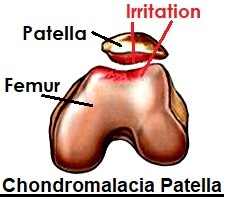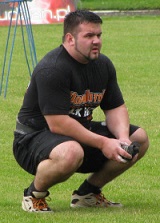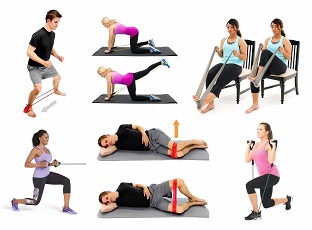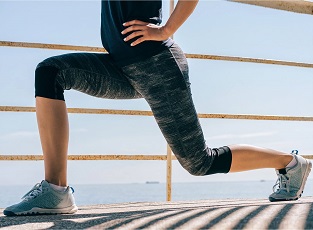- Home
- Knee Symptoms
- Knee Pain On Stairs
Knee Pain Going Down Stairs
Written By: Chloe Wilson, BSc(Hons) Physiotherapy
Reviewed by: KPE Medical Review Board
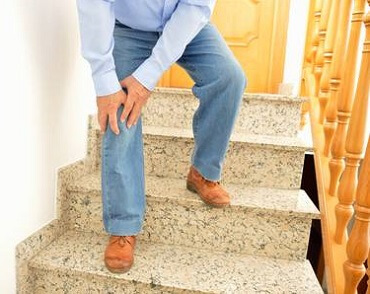
Knee pain going down stairs, and as you go back up, is a common problem and can make life really tricky.
It is not surprising so many people complain of pain when you consider that the force going through the kneecap is 3.5x body weight when you come down the stairs.
That means for a person weighing 120lbs, as they come down, a force of 420lbs goes through the kneecap which has a contact surface area of only 12cm2.
Here we look at the common causes of knee pain coming down stairs and steps, how to reduce pain and improve function and share top tips on the best way to get up and down stairs if you suffer from knee pain.
Why Do Knee's Hurt On Stairs?
In most cases knee pain going down stairs usually indicates a problem with the knee cap (patella) and how it moves. The kneecap is a small bone, shaped like an upside down triangle which sits in the patella groove at the front of the knee and glides up and down as the knee moves.
Huge forces go through it with every day activities. As a result, the back of the patella is lined with the thickest layer of cartilage in the whole body as it is designed to withstand massive compressive forces.
Anything that interferes with how the patella moves, or that affects the cartilage lining the knee cap will magnify these huge forces and lead to knee pain going down stairs.
Common Causes of Knee Pain Going Down Stairs
The four most common causes of knee pain going down stairs are:
1. Runners Knee
Runners Knee, also known as Anterior Knee Pain or Patellofemoral Pain Syndrome, is the most common cause of knee pain going down stairs.
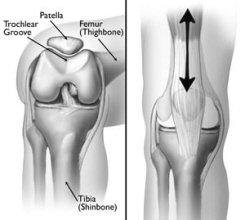
What is it: Runners Knee is a condition where there is a problem in the way the patella moves up and down
Causes: Muscle tightness/weakness, flat feet, abnormal anatomy
Symptoms: General ache and knee cap pain, grinding, mild swelling
Aggravating Activities: Repeated activities, stairs, prolonged inactivity
Who Does it Affect: Can affect anyone, at any age, whether they are active or not. Accounts for approximately 25% of all knee injuries seen in sports injury clinics
Learn More: in the Runners Knee section
2. Chondromalacia Patella
What is it: Chondromalacia is a conditions where there is damage to the cartilage on the back of the kneecap
Symptoms: Achy knee cap pain, swelling, clicking/grinding
Aggravating Activities: Getting up from sitting, sports, pressure through the kneecap, stairs
Who Does it Affect: Most common in young, healthy people. More common in women.
Learn More: in the Chondromalacia Patella section
3. Knee Osteoarthritis
What is it: In osteoarthritis, there are degenerative changes aka wear and tear in the knee bones and cartilage of the knee
Symptoms: Morning stiffness, pain, swelling, clicking/grinding, reduced knee movements
Aggravating Activities: Worse after prolonged rest, activity, cold weather, stairs
Who Does It Affect: Most common over the age of 50
Learn More: in the Arthritis section
4. Pes Anserine Bursitis
What is it: With Pes Anserine bursitis, the problem is not with the kneecap directly, but inflammation of the nearby pes anserine bursa, a small fluid filled sac that reduces friction between knee tendons and bone
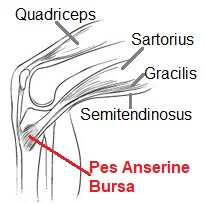
Symptoms: Pain and swelling approximately 2-3 inches below the knee joint on the inner side of the knee
Aggravating Activities: Stairs (going up tends to be worse than coming down), sleeping on your side (due to pressure on the bursa), hamstring stretches
Who Does It Affect: Most common in overweight women, runners and swimmers (particularly breaststroke)
Learn More: In the Pes Anserine Bursitis section
5. Quads Strain
What is it: A quads strain is when one or more of the quadriceps muscles on the front of the thigh are partially or fully torn
Symptoms: Thigh pain, swelling and bruising, impaired function, quads weakness
Aggravating Activities: Knee pain going down stairs, jumping, kicking
Who Does It Affect: Mostly athletes, particularly during middle age
Learn More: In the Pulled Quads section
How To Beat Knee Pain On Stairs
Whatever is causing your knee pain going down stairs or upstairs, don’t despair. There are loads of simple things you can do to make it easier to get up and down the stairs and to reduce your knee pain.
For example, did you know it can make a huge difference which leg you lead
with as you go up and down. It might also be that increasing the strength or mobility in your knee
helps or that changing when or how you use the stairs makes a real difference.
Check out the How To Beat Knee Pain On Stairs article for our top 10 tips on how to do stairs with knee pain.
Forces Through The Knee Cap
People often don't realise quite how much the force through the knee varies in different situations. Let's have a quick look at the forces that go through the kneecap with different activities.
- Walking: 0.5x body weight
- Climbing Up Stairs: 2.5x body weight
- Going Down Stairs: 3.5x body weight
- Squatting: 7-8x body weight
It really highlights why some activities cause so much pain in the knees!
Want To Know More?
Of course, lots of knee problems will feel worse on the stairs, but these are the five problems where knee pain on stairs is one of the most prominent features.
You may be interested in the following articles:
- Front Knee Pain
- Pain Above Knee
- Sharp Knee Pain
- Knee Pain At Night
- Knee Strengthening Exercises
- Knee Stretching Exercises
- Top Tips On Climbing Stairs With Knee Pain
If none of these are sounding like your problem, visit the knee pain diagnosis section, for help working out was is causing your pain, and to learn what you can do about it.
Page Last Updated: 20/06/23
Next Review Due: 20/06/25
Related Articles
Resistance Band Exs
December 7, 2023
Diagnosis Chart
March 25, 2025
Improve Flexibility
September 30, 2025
